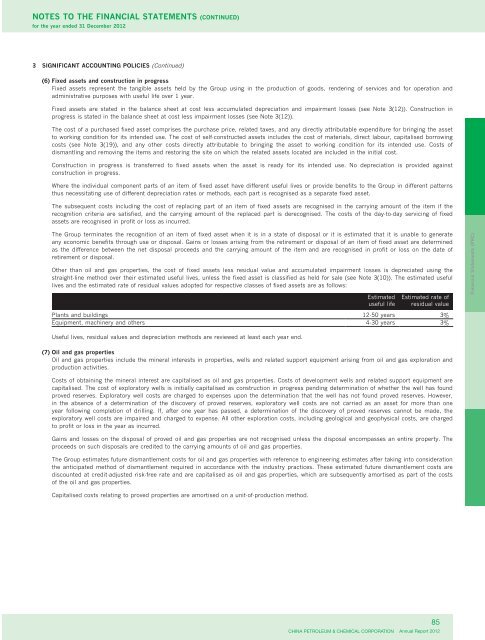Annual Report 2012
Annual Report 2012
Annual Report 2012
You also want an ePaper? Increase the reach of your titles
YUMPU automatically turns print PDFs into web optimized ePapers that Google loves.
NOTES TO THE FINANCIAL STATEMENTS (CONTINUED)<br />
for the year ended 31 December <strong>2012</strong><br />
3 SIGNIFICANT ACCOUNTING POLICIES (Continued)<br />
(6) Fixed assets and construction in progress<br />
Fixed assets represent the tangible assets held by the Group using in the production of goods, rendering of services and for operation and<br />
administrative purposes with useful life over 1 year.<br />
Fixed assets are stated in the balance sheet at cost less accumulated depreciation and impairment losses (see Note 3(12)). Construction in<br />
progress is stated in the balance sheet at cost less impairment losses (see Note 3(12)).<br />
The cost of a purchased fixed asset comprises the purchase price, related taxes, and any directly attributable expenditure for bringing the asset<br />
to working condition for its intended use. The cost of self-constructed assets includes the cost of materials, direct labour, capitalised borrowing<br />
costs (see Note 3(19)), and any other costs directly attributable to bringing the asset to working condition for its intended use. Costs of<br />
dismantling and removing the items and restoring the site on which the related assets located are included in the initial cost.<br />
Construction in progress is transferred to fixed assets when the asset is ready for its intended use. No depreciation is provided against<br />
construction in progress.<br />
Where the individual component parts of an item of fixed asset have different useful lives or provide benefits to the Group in different patterns<br />
thus necessitating use of different depreciation rates or methods, each part is recognised as a separate fixed asset.<br />
The subsequent costs including the cost of replacing part of an item of fixed assets are recognised in the carrying amount of the item if the<br />
recognition criteria are satisfied, and the carrying amount of the replaced part is derecognised. The costs of the day-to-day servicing of fixed<br />
assets are recognised in profit or loss as incurred.<br />
The Group terminates the recognition of an item of fixed asset when it is in a state of disposal or it is estimated that it is unable to generate<br />
any economic benefits through use or disposal. Gains or losses arising from the retirement or disposal of an item of fixed asset are determined<br />
as the difference between the net disposal proceeds and the carrying amount of the item and are recognised in profit or loss on the date of<br />
retirement or disposal.<br />
Other than oil and gas properties, the cost of fixed assets less residual value and accumulated impairment losses is depreciated using the<br />
straight-line method over their estimated useful lives, unless the fixed asset is classified as held for sale (see Note 3(10)). The estimated useful<br />
lives and the estimated rate of residual values adopted for respective classes of fixed assets are as follows:<br />
Estimated Estimated rate of<br />
useful life residual value<br />
Plants and buildings 12-50 years 3%<br />
Equipment, machinery and others 4-30 years 3%<br />
Useful lives, residual values and depreciation methods are reviewed at least each year end.<br />
(7) Oil and gas properties<br />
Oil and gas properties include the mineral interests in properties, wells and related support equipment arising from oil and gas exploration and<br />
production activities.<br />
Costs of obtaining the mineral interest are capitalised as oil and gas properties. Costs of development wells and related support equipment are<br />
capitalised. The cost of exploratory wells is initially capitalised as construction in progress pending determination of whether the well has found<br />
proved reserves. Exploratory well costs are charged to expenses upon the determination that the well has not found proved reserves. However,<br />
in the absence of a determination of the discovery of proved reserves, exploratory well costs are not carried as an asset for more than one<br />
year following completion of drilling. If, after one year has passed, a determination of the discovery of proved reserves cannot be made, the<br />
exploratory well costs are impaired and charged to expense. All other exploration costs, including geological and geophysical costs, are charged<br />
to profit or loss in the year as incurred.<br />
Gains and losses on the disposal of proved oil and gas properties are not recognised unless the disposal encompasses an entire property. The<br />
proceeds on such disposals are credited to the carrying amounts of oil and gas properties.<br />
The Group estimates future dismantlement costs for oil and gas properties with reference to engineering estimates after taking into consideration<br />
the anticipated method of dismantlement required in accordance with the industry practices. These estimated future dismantlement costs are<br />
discounted at credit-adjusted risk-free rate and are capitalised as oil and gas properties, which are subsequently amortised as part of the costs<br />
of the oil and gas properties.<br />
Capitalised costs relating to proved properties are amortised on a unit-of-production method.<br />
85<br />
CHINA PETROLEUM & CHEMICAL CORPORATION <strong>Annual</strong> <strong>Report</strong> <strong>2012</strong><br />
Financial Statements (PRC)


